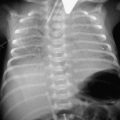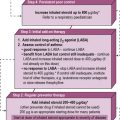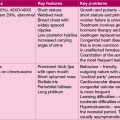15 The mind
Examination
Organic disease from constipation to brain tumours may present with problematic behaviour. On occasion, the abnormal behaviour leads to physical ill health, e.g. anorexia nervosa. A child’s physical features may give clues about their behaviour. For example, a number of chromosomal disorders, such as fragile X, Prader–Willi and Klinefelter syndromes (see Chapter 18, Table 18.2) have particular behavioural characteristics. If necessary, any investigations should ideally be done at the beginning to identify physical health problems.
Tantrums
What are tantrums?
Toddlers like being ‘in charge’ (as can be seen in Case 15.1). This desire is often thwarted by their abilities and the limits set by their parents. For example, 2-year-olds may want to eat their meal with their parents’ cutlery although they do not have the fine motor skills to do so, or their parents may prevent them from adding tomato sauce to their ice cream, for example.
Hyperactivity
What is attention deficit hyperactivity disorder?
The girl’s condition in Case 15.2 is an example of attention deficit hyperactivity disorder (ADHD) which is a triad of inattention, impulsivity and hyperactivity, with impairment of social or educational functioning as a consequence. In order to make the diagnosis, these difficulties should be seen before the age of 7 years and usually much younger. The patterns of behaviour need to be chronic (of at least 6 months’ duration), pervasive – i.e. they affect the child in two or more situations, such as at home, at school, or with grandparents and friends – and cause functional impairment.
Management
Autistic spectrum disorders
Case 15.3 describes a boy with autism and demonstrates some of the key features of the autistic spectrum.
Key features of autistic spectrum disorders
Intervention
Intervention begins with early diagnosis. Interagency agreement about diagnosis and joint planning of intervention is essential (see also Chapter 3, p. 20). Key individuals include speech and language therapists, educational and clinical psychologists, specialist nurses and ideally an identified key worker to help the family negotiate the bureaucratic maze. Special schooling may be necessary. Transition to adult services is often fraught, as support is much less readily available.
Depression
What is depression?
The resilience of children to cope with stress, including bereavement (as in Case 15.4), is dependent on the child’s previous experiences coupled with the number and severity of other problems they have to face. A seemingly minor event may be more significant for a child than the parents realize (e.g. the death of a pet, loss of a friend) and normal sadness gives way to depression. There may be a family history of depression. Symptoms include diurnal variation in mood, being worse in the morning, irritability, low energy, poor self-esteem and thoughts of suicide. Interviewing the child may well elicit symptoms otherwise unknown to the parents. Poor appetite, sleep problems and other psychiatric conditions may be present.
School refusal
Difficult transitions in childhood can precipitate the onset of behaviour which presents to the doctor as ‘illness’ (as in Case 15.5). Perhaps it is better to view the child as stuck in a ‘predicament’ that brings him to professional attention.
Chronic fatigue syndrome/myalgic encephalomyelitis
Definition
Chronic fatigue syndrome/myalgic encephalomyelitis (CFS/ME) is defined as medically unexplained fatigue of at least 3 months’ duration (as in Case 15.6). Post-exertional malaise and unrefreshing sleep are characteristic.
Substance abuse
Children and adolescents are exposed to a variety of legal and illegal substances and the health effects vary. Rarely, acute intoxications of drugs or alcohol lead to hospital admission. Usually these behaviours do not precipitate immediate health problems, but can be the start of dependency or addiction that persists into adult life. The commonest substances used are tobacco and alcohol. Other than marijuana, illicit drug use under 16 years is relatively uncommon. As Case 15.7 illustrates the issues around these behaviours are complex both for families and society.
Eating disorders
Anorexia nervosa
Anorexia nervosa usually presents with insidious weight loss, often with excessive exercise and always with deception around food intake (as in Case 15.8). The child may like cooking and food, but denies having an appetite. Anorexia nervosa is much commoner in girls (the male to female ratio is 1:10), with as many as 1% of adolescent girls being affected. The characteristics are inappropriately low body weight (<15% under expected weight-for-height), intense fear of fatness, even when weight loss is achieved, and disordered body image, usually with accompanying physical sequelae such as amenorrhoea.
Connexions http://www.connexions-direct.com
Frank http://www.talktofrank.com
McCann D., Barrett A., Cooper A., et al. Food additives and hyperactive behaviour in 3-year-old and 8/9-year-old children in the community: a randomised, double-blinded, placebo-controlled trial. Lancet. 2007;370(9598):1560–1567.
Royal College of Psychiatrists. Mental health information and growing up. http://www.rcpsych.ac.uk






